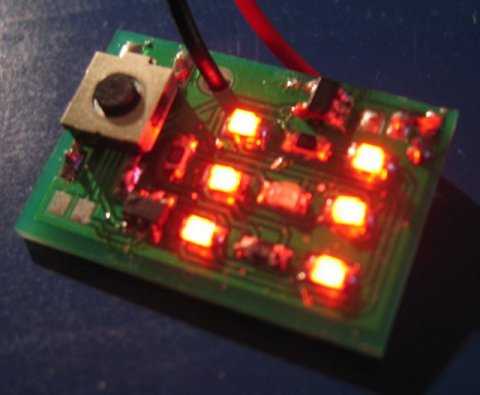Table Of Contents
by: Rickard Gunée
http://www.rickard.gunee.com/projects/mixed/dice
Introduction
This project describes a PIC10F200-based electronic dice. The reason I made this was that I had a small corner left over when ordering a panel with a couple of other PCBs and thought I would rather use the corner for something interesting than leave it unused, so I made a dice project. The PCB is quite small, so it is hard to etch it yourself.
Even though this is a very simple project, it requires some surface mount soldering skills, proper tools, and a steady hand as it is built with surface mount components only. But it might be a good start if you have experience with through-hole soldering and want to try surface mount.

The complete project
Hardware
The standard solution for a power supply is to use a 7805 but I could not find any 7805 in a sot-23 or smaller outline so I used an LP2985 that is available in a 5-pin sot-23 with 5v/150mA output. I use a 100nF cap on both input and output side of the regulator to get rid of noise etc. I’m using a standard 9v battery to supply the circuit. In the PCB-layout there is also a hole for the cable to remove mechanical tension from the soldering point.
The PIC controlling the dice is a PIC10F20X, but it is also possible to use a PIC10F22X (that is what is sold in my web shop as it is almost the same price so I use the 10F222 to get fewer chips in stock as other projects use the 10F222), both are microcontrollers with very limited RAM and ROM, 16b/256w of RAM/ROM but there are versions with up to 24b/512w. The 10F22X series also has an ADC but that is not needed in this project. Two of the six pins are used for power supply, there is one reset (or input only) pin and three IO-pins. The switch is connected to the input pin. The three IO-pins are used to drive a 2x2 matrix configuration of the seven LEDs. Some of the the LEDs are connected in series and lit in three sets of two on opposite sides in series and one single LED in the center. The 2x2 matrix configuration is created with three pins by putting the LEDs in opposite directions so when the common line is “0” some LEDs are lit and when the common is “1” other LEDs are lit. This leads to only two sets of LEDs can be lit at one time, either the LEDs in the corners or the ones in the middle. When scanning at 100Hz between the different LEDs it look like they are all lit at the same time thanks to the persistence of vision effect. There are some resistors in series with the LEDs as the system runs on 5v and the LEDs have a voltage drop of about 2v each. One nice feature of the PIC10F-series is the current consumption, especially in sleep mode. This removes the need for an on/off switch as the dice only uses 0.4uA in standby, so it can be in standby for many years without using up the battery.
Software
The software is very simple, not very good looking and not very optimized but the 16 bytes of RAM and 256 words of ROM are more than enough so there is no need for optimizations (except for the optimizations that are fun to do). It has a main loop that lights some of the LEDs in one pass and the other LEDs in a second pass. The state engine has four states IDLE, WAIT, ROLL and SHOW. When in the idle state the PIC is set to sleep state and is woken up on pin change (when the switch is pushed). In the wait state, a roll pattern is shown and a counter is generating a random number based on how long the user pushes the button (not a very good random generator but if the button is pushed longer than the mechanically shortest possible time it is quite ok). In the ROLL state the roll animation is shown for two additional seconds just to make it more exciting. Finally in the SHOW state the result is shown for 3.5sec before getting back to IDLE, unless the button is pushed and it starts another roll.
Before “taking on” the PIC10Fxxx” the cost of these chip is higher than the PIC12F629 as the PIC12F629’s are sold in larger quantities and thus the costs are less.
This project is only shown as “an idea.” Using a PIC12F629 will save multiplexing the display and produce a brighter output. Also, using a 9v battery and regulator is very wasteful. The supply can be 3 button cells, with no wasted “excess voltage.”
The dice is built with seven LEDs placed like this:

Quick Links
Legal Stuff
Social Media
